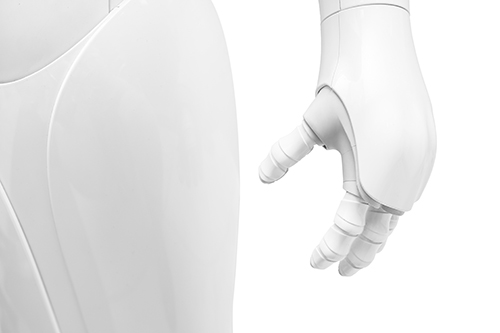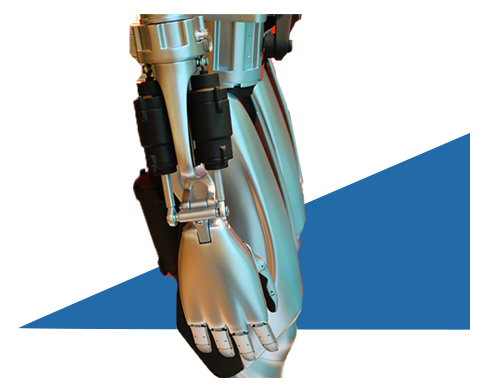Humanoid Robotics: Revolutionizing Precision with Strain Gage (Gauge) Technology
At Micro-Measurements, we are dedicated to assisting engineers globally in acquiring precise and dependable strain data. Our commitment to excellence is reflected in our innovative product design and comprehensive engineering support. Micro-Measurements Strain Gages are meticulously crafted to address the increasing need for high-precision, scalable solutions in force sensing OEM applications and Experimental Stress Analysis. Trust us to provide cutting-edge technology and reliable solutions for your engineering challenges.
Custom Strain Gauge Sensors for Humanoid Robotics
Robotic solutions from the name that means precision
Humanoid robots require highly accurate and responsive sensing to walk, grip, balance, and interact with the world. This site explores how custom strain gauge sensors solve challenges off-the-shelf solutions cannot—boosting performance and enabling the next generation of intelligent systems.
Current force and torque sensing applications, especially in Humanoid
Robotics, pose several challenges, including:
Sensor Precision and Accuracy
Achieving high precision and accuracy in force and torque measurements is crucial for robotic applications, especially in tasks that require delicate manipulation or interaction with the environment.
Integration Complexity
Integrating force and torque sensors seamlessly into robotic systems can be complex. Ensuring compatibility with existing robotic hardware and control systems
while maintaining a compact and lightweight design is a challenge.
Environmental Variability
Robots often operate in diverse and unpredictable environments. Force and torque sensors must be robust enough to withstand variations in temperature, humidity,
and other environmental conditions without compromising
accuracy or reliability.
Dynamic Environments
Robotics involves dynamic movements and interactions. Force and torque sensors must respond quickly and accurately to sudden changes in force or torque,
providing real-time feedback to the control system for dynamic
control and adaptability.
Cost Considerations
High-quality force and torque sensors can be expensive, impacting the overall cost of robotic systems. Balancing the need for precision with cost-effectiveness is a
challenge, especially in applications where multiple sensors are
required.
Sensor Interference
Sensors may be susceptible to interference from other electronic components or external sources, potentially affecting the accuracy of force and torque measurements. Robust shielding and signal processing techniques are
essential to mitigate interference.
Durability and Reliability
Robotic systems may experience wear and tear over time due to continuous operation. Ensuring the durability and long-term reliability of force and torque
sensors is essential to maintain consistent performance
throughout the robot's lifecycle.

Adaptability to Different Robot Configurations
Robots come in various configurations and designs. Force and torque sensors
should be adaptable to different robot types and structures, allowing
for easy integration into diverse robotic platforms.
Real-time Data Processing
Processing and interpreting force and torque data in real-time present computational challenges. Efficient algorithms and computing resources are needed to extract meaningful information from the sensor data promptly.
Safety Standards Compliance
Meeting safety standards is critical, especially in collaborative robot applications where robots work alongside humans. Ensuring that force and torque sensors
meet industry safety requirements is essential to prevent accidents
and ensure user safety. Addressing these challenges requires
collaboration between sensor manufacturers and robotic engineers, to
develop innovative solutions that enhance the capabilities and
reliability of force and torque sensing in robots.

Micro-Measurements strain gage-based force and torque sensors in robotics applications offer many advantages
High Accuracy
Strain gage-based sensors provide high-precision measurements,
making them suitable for applications where accurate force
and torque data are critical, such as delicate manipulation tasks
and force control.
Wide Measurement Range
These sensors can be designed to accommodate a wide range of
force and torque levels, allowing for versatility in robotic applications.
From subtle interactions to high-force tasks, strain gauge
sensors can be tailored to meet specific requirements.
Customizability
Strain gage-based sensors can be customized in terms of size,
shape, and sensitivity to fit the specific needs of different robotic
systems. This adaptability makes them suitable for a variety of robotic configurations and applications. In humanoid robots, each sensor must meet specific requirements in terms of size, capacity, and the ability to fit into small and confined spaces.
Compact Design
The compact size and lightweight nature of strain gage sensors
make them well-suited for integration into robotic systems without
adding significant weight or bulk. This is crucial for maintaining the
agility and efficiency of robotic movements.
The Micro-Measurements full-bridge solution delivers accurate signals with a minimal sensor footprint
Real-time Feedback
Strain gage sensors can provide real-time feedback on force and
torque, enabling robots to adjust their movements dynamically.
This feature is valuable for tasks that require immediate responses
to changes in the environment or load conditions. Linearity, repeatability,
and stability are the core parameters of the strain gage-based sensors.
Durability
Strain gauge sensors are built to be robust and durable, with
the ability to withstand harsh environmental conditions and repetitive
use. This durability is essential for the longevity of robotic
systems in industrial settings. Micro-Measurements strain gage-based solutions have been used in this industry for many years, with a proven track record of long-term sensor stability unparalleled by other technologies.
Cost-effectiveness
Compared to some alternative sensor technologies, strain
gauge-based sensors can offer a cost-effective solution for force
and torque sensing in robotics. This makes them accessible for a
broader range of applications and industries.
Compatibility with Materials
Strain gauges can be bonded to various materials, including
metals and composite materials commonly used in robotics. This
flexibility in material compatibility enhances the ease of integration
into different robotic structures.
Low Inertia
The low mass and inertia of strain gauge sensors contribute to the
overall efficiency of robotic systems. They don't significantly
impede the robot's movements or responsiveness, making them
suitable for high-speed and dynamic applications.
Proven Technology
Strain gauge technology has been widely used and tested in
various engineering applications, establishing its reliability and
credibility. This track record makes strain gauge-based force and
torque sensors a trusted choice for robotic applications.
Strain gauge-based sensors play a crucial role in building better actuators for humanoid robots by providing accurate and real-time feedback on mechanical deformations.
Here are several ways in which strain gauge-based sensors contribute to the improvement of humanoid robot actuators:
Precision and Accuracy
Strain gauges offer high precision and
accuracy in measuring mechanical deformations, allowing for
precise control of joint movements in humanoid robots. This accuracy
is essential for achieving natural and human-like motions.
Real-time Feedback
Strain gauge sensors provide real-time
feedback on the strain or deformation experienced by the actuator.
This feedback enables closed-loop control systems, allowing
the robot to adjust its movements dynamically based on the external
forces or changes in the environment.
Force Sensing
Strain gauges can be used to measure the force
applied to or exerted by the actuator. This force sensing capability
is valuable for tasks that require interaction with the environment
or objects, such as grasping and manipulation.
Torque Sensing
Humanoid robots often require precise control
of joint torques to execute coordinated movements. Strain
gauges integrated into the actuators can measure the torque
applied at the joints, contributing to better control and coordination.
Compliance and Safety
Strain gauge-based sensors allow for
the implementation of compliance in robotic joints. This compliance
enables safer interactions with humans and the environment
by providing a certain level of flexibility and shock absorption,
reducing the risk of injury during physical contact.
Dynamic Load Sensing
Humanoid robots may encounter dynamic
and variable loads during operation. Strain gauges can
dynamically sense and respond to changes in load, ensuring that
the actuators adjust to varying conditions for optimal performance.
Monitoring Structural Integrity
Strain gauges can be used to
monitor the structural integrity of the robot's components, detecting
any signs of fatigue, wear, or potential failure. This proactive
monitoring enhances the overall reliability and durability of humanoid
robot actuators.

Optimizing Energy Efficiency
By providing real-time feedback on the forces and deformations experienced by the actuators, strain gages help improve energy efficiency. This
feedback allows for more efficient control strategies, minimizing
energy consumption while maintaining performance.
Adaptability to Different Tasks
Strain gauge-based sensors make humanoid robot actuators adaptable to a wide range of
tasks. Whether the robot is performing precise and delicate
movements or exerting force for manipulation, the strain gauge
feedback ensures that the actuator can adjust its behavior accordingly.
Research and Development
Strain gauge-based sensors facilitate research and development in robotics by providing valuable data for analyzing and improving the performance of humanoid
robot actuators. Researchers can use this data to refine control
algorithms and enhance the overall capabilities of the robot.
The integration of strain gauge-based sensors into humanoid robot actuators enhances their precision, adaptability, safety, overall performance. This technology enables more sophisticated and human-like robotic movements, making humanoid robots more capable and versatile in various applications.




